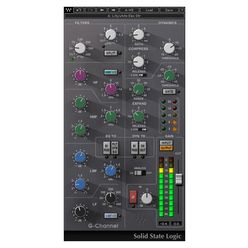

What I want for these room mics is my compressor to be heavily compressing this signal, however I don’t want it to be activated by the kick drum. The filters then are no longer affecting the actual signal that’s gonna pass through, but it’s affecting a signal that’s separated out and that goes into the dynamics section.

What I’ve got when you engage this one is you put the filter section in the sidechain of the compressor. For the overheads and room mics I’m going to be doing some side-chaining. I’ve got the G-Channel going, and what I’m doing, is I’ve got the filter dynamics sidechain engaged. I’ll start out with this pair of room mics. Next let’s go over here to the overhead and room mics and see what’s going on with them. I’ve got the channel output engaged so that the equalizer section is before the dynamics section. I’m doing a similar sort of thing with the E-Channel. Now you see the compressor doing more work. If I roll everything out, you’ll see that the compressor is not doing as much here, meaning that the equalizer - the signal I’m taking out - is in front in fact of the compressor. I’ve also got the split engaged which also puts the filters in front of the dynamics section. What this channel out button is going to do is put the equalizer in front of the dynamics section. On my snare bottom mic I’ve decided to use this channel out button. I’ve got the filters going before the dynamics and thing going into the equalizer. Even though it’s the G-Channel strip, it’s gonna do a similar sort of thing.

Next let’s get to the G-Channel I’ve got inserted on the snare drum. And that’s just putting the filters before the dynamics section. I’m doing a similar thing on the sub kick. To demonstrate that the compressor is not listening to it, if I roll it off, it’s no longer listening. This is a popular way to use the plugin, especially for things like kick drum or bass where in the first situation the compressor was sensitive to the really low frequencies, but by putting the filter in front, now the compressor and gate are no longer listening to those really low frequencies that you’re going to roll off anyways. This can be done if you don’t want your really low end signal triggering the compressor. What this is going to do is move the filter section in front of the dynamics. On the external microphone I’m still using the E-Channel, but i’ve clicked on the split button right here. I’m rolling off around 200 and 300 Hz to take away the boxiness and then boosting finally around 60 Hz just so I can kind of fill out the bottom end of my kick drum. And I have a 4-band equalizer, boosting a little bit around 2k and up around 5k to give it some snap and punch. What I’m doing here is just a little bit of compression and then the expander/gate, then I’m going into the filter section which has a high pass starting around 40 Hz, and then a low pass around 10k. I’ve got it in it’s default settings, and the default routing is to first start out with the dynamics section then go into my filter section, and finally the EQ section. Because the routing is a little bit different on each of these plugins.įirst I’ll start off with my kick drum track. On some of the tracks I’ve inserted the E-Channel Strip and on other ones I’ve inserted the G-Channel strip. I have kick drum over here, snare drum, toms, overhead and a couple room mics. Here I have a multitrack drum recording with consists of several different microphones on the drum kit. Why don’t we get to an example and I can show you all the different options. You can also use the internal routing options to do more advanced techniques such as de-easing. Or put you dynamics section before you equalizer. Internal routing options can be used to change the order of these sections such as putting your equalizer before you dynamics section.

Another section is the 4-band equalizer, and the last section is the dynamics section which consists of the compressor and expander/gate. There are three sections: one section is the filters section, which consists of a high pass and low pass filter. These options change the order of the various sections of the plugins. One thing that might be overlooked when first using the plugins is the internal routing options. They sound great, they can also be used as an all-in-one effects processing unit. The Waves SSL E-Channel Strip and G-Channel Strip are some of the most popular plugins for mixing, and for good reason.


 0 kommentar(er)
0 kommentar(er)
